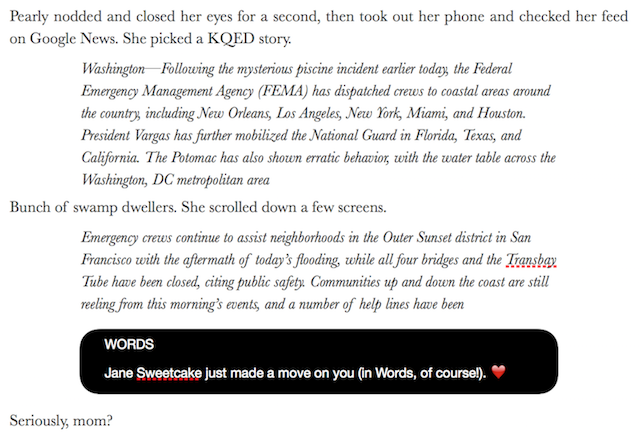(cross-posted)
Formatting is fun.
Time was, when you were ready to have a book published, you sent off your typewritten manuscript to the publisher and they determined what sort of physical form this would take. Typeface, page size, font size, paper stock, often cover art, hardcover vs. trade paperback, all that stuff.
That’s still true, to a large degree, but all the advances in technology for dead-tree printing have really let us go to town with creative formatting. This can take a variety of forms. I’m going to lead, however, with a historical example.
William Faulkner wanted The Sound and The Fury to be published with more than just black ink on white paper. (Well, he didn’t have anything to say about the paper.) But I do know that he wanted multiple ink colors to indicate the various speakers and time periods and intersections thereof. My recollection from undergrad is that he wanted four colors (or perhaps five if you include black); the Times article above suggests fourteen. At any rate, the publisher said ‘no’, because that would have been super expensive in 1929. (The ultra-deluxe 14-color modern edition linked above sold for $345 at printing, though I doubt this was strictly necessary and is almost certainly a case of conspicuous consumption for lit nerds.)
There’s an interesting discussion of how the new coloration may actually make the book too non-difficult to read. I wouldn’t know, since I read the broke undergrad Penguin Classics version, but it’s an interesting thought. I have the impression that The Sound and The Fury is sort of a rite of passage, and that this makes accessibility a bad thing, to a certain type of person. That’s a topic for another time I suppose.
So that was then, and this is now. Custom formatting is cheaper and easier, yay! I’ll admit that I first started noticing it when I was reading Cell by Stephen King, which would have been, gosh, ten years ago. One of the recurring images is the main character being crushed by a piece of construction equipment. The equipment’s brand is Link-Belt. “Here comes Link-Belt!” is I believe the refrain. But it’s in sort of a font like “Here comes LINK-BELT!” And as it gets closer and closer to crushing his leg (debilitating leg injuries are something of a motif for Mr. King), it gets bigger.
“Here comes LINK-BELT!”
“Here comes LINK-BELT!”
“Here comes LINK-BELT!”
(To this day, when I pass a construction site on the highway and see a LINK-BELT piece of machinery, I think of that.)
That’s fun. And technology is letting us do more stuff like that in more things ‘cuz cheap production, which is good. It even lets us do some completely bugf— crazy things like this.

House of Leaves (Mark Z. Danielewski) is, uh, a thing that exists. (I did not take this picture.) It’s weird. Leaving aside the question of whether or not it pulls off what it’s trying to do, let nobody say that it doesn’t try to do it. And it just wouldn’t even exist if it we didn’t have the ability to do something like this for a few (seven) hundred pages relatively cheap. It costs about as much as any other roughly-letter-sized 700-page book. We aren’t talking about asking the publisher ‘can I use Helvetica instead of Times’? We aren’t talking about something like The Sound and The Fury here, where it’s maybe better/closer to the original intent if you have a few extra colors. Cheap formatting is an existential requirement for this book.
Yay cheap formatting! I’m generally in favor of books existing! Really going out on a limb there, I know!
Obviously this is even easier in digital formats. I’m going to go out on another limb and include web sites in that calculation. Philosophically they’re just books with javascript and a database, or perhaps more like the memex, but the relevant thing is, these were all conceived of as digital text, and in this sense ‘text’ means ‘a document’ and ‘a document’ means ‘a book’. (This is a lie, but a convenient one.)
Anywho, formatting is cool, and it lets you do things with a text that you couldn’t do before, and that’s good. Here’s something from the re-draft of (new working title) The World Beyond Eels:




